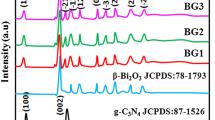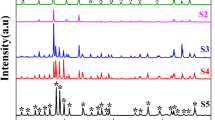Abstract
In this work, leaf-like β-Bi2O3/g-C3N4 nanosheets composites were synthesized via a simple in situ method. β-Bi2O3/g-C3N4 nanocomposites were obtained via calcining the mixtures of g-C3N4 and metallic Bi, while, at the same temperature, in the absence of g-C3N4, metallic Bi formed α-Bi2O3. The presence of β-Bi2O3 in the composite was demonstrated by X-ray diffraction, high-resolution transmission electron microscopy (HRTEM) and X-ray photoelectron spectroscopy analysis. From scanning electron microscope analysis, the morphology of leaf-like β-Bi2O3 and the g-C3N4 nanosheets were observed. The as-prepared β-Bi2O3/g-C3N4 composite exhibited higher photocatalytic activity than both pure β-Bi2O3 and g-C3N4 for photocatalytic degradation of methylene blue under visible light. The active species capture experiments and photoluminescence experiments illustrated that the degradation mechanism followed the Z-scheme mechanism. This proposed method provides an efficiency way to prepare potential visible light responsive materials for wastewater treatment.











Similar content being viewed by others
References
W. Wang, J. Zhou, Z. Zhang, J. Yu, W. Cai, Different surfactants-assisted hydrothermal synthesis of hierarchical γ-Al2O3 and its adsorption performances for parachlorophenol. Chem. Eng. J. 233, 168–175 (2013). https://doi.org/10.1016/j.cej.2013.08.029
W. Wang, J. Zhou, G. Achari, J. Yu, W. Cai, Cr(VI) removal from aqueous solutions by hydrothermal synthetic layered double hydroxides: adsorption performance, coexisting anions and regeneration studies. Colloids Surf. A 457, 33–40 (2014). https://doi.org/10.1016/j.colsurfa.2014.05.034
J. Boonnorat, S. Techkarnjanaruk, R. Honda et al., Enhanced micropollutant biodegradation and assessment of nitrous oxide concentration reduction in wastewater treated by acclimatized sludge bioaugmentation. Sci. Total Environ. 637–638, 771–779 (2018). https://doi.org/10.1016/j.scitotenv.2018.05.066
M. Mousavi, A. Habibi-Yangjeh, S.R. Pouran, Review on magnetically separable graphitic carbon nitride-based nanocomposites as promising visible-light-driven photocatalysts. J. Mater. Sci. 29, 1719–1747 (2017). https://doi.org/10.1007/s10854-017-8166-x
Y. Zhang, J. Zhou, Z. Li, Q. Feng, Photodegradation pathway of rhodamine B with novel Au nanorods @ ZnO microspheres driven by visible light irradiation. J. Mater. Sci. 53, 3149–3162 (2017). https://doi.org/10.1007/s10853-017-1779-x
Y. Sun, J. Zhou, W. Cai, R. Zhao, J. Yuan, Hierarchically porous NiAl-LDH nanoparticles as highly efficient adsorbent for p-nitrophenol from water. Appl. Surf. Sci. 349, 897–903 (2015). https://doi.org/10.1016/j.apsusc.2015.05.041
J. Zhou, J.B. Zhou, W.Q. Cai, R.S. Zhao, J.P. Yuan, Hierarchically porous Zn/Al layered double hydroxides intercalated with citrate and their adsorption toward parachlorophenol in water. Integr. Ferroelectr. 162, 102–112 (2015). https://doi.org/10.1080/10584587.2015.1039444
S.-M. Lam, J.-C. Sin, A.R. Mohamed, A review on photocatalytic application of g-C3N4/semiconductor (CNS) nanocomposites towards the erasure of dyeing wastewater. Mater. Sci. Semicond. Process. 47, 62–84 (2016). https://doi.org/10.1016/j.mssp.2016.02.019
X.C. Wang, K. Maeda, A. Thomas et al., A metal-free polymeric photocatalyst for hydrogen production from water under visible light. Nat. Mater. 8, 76–80 (2009). https://doi.org/10.1038/NMAT2317
D. Masih, Y. Ma, S. Rohani, Graphitic C3N4 based noble-metal-free photocatalyst systems: a review. Appl. Catal. B 206, 556–588 (2017). https://doi.org/10.1016/j.apcatb.2017.01.061
S. Ye, R. Wang, M.-Z. Wu, Y.-P. Yuan, A review on g-C3N4 for photocatalytic water splitting and CO2 reduction. Appl. Surf. Sci. 358, 15–27 (2015). https://doi.org/10.1016/j.apsusc.2015.08.173
L. Yang, J. Huang, L. Shi et al., A surface modification resultant thermally oxidized porous g-C3N4 with enhanced photocatalytic hydrogen production. Appl. Catal. B 204, 335–345 (2017). https://doi.org/10.1016/j.apcatb.2016.11.047
H. Yang, K. Lv, J. Zhu et al., Effect of mesoporous g-C3N4 substrate on catalytic oxidation of CO over Co3O4. Appl. Surf. Sci. 401, 333–340 (2017). https://doi.org/10.1016/j.apsusc.2016.12.238
Y. Shang, X. Chen, W. Liu et al., Photocorrosion inhibition and high-efficiency photoactivity of porous g-C3N4/Ag2CrO4 composites by simple microemulsion-assisted co-precipitation method. Appl. Catal. B 204, 78–88 (2017). https://doi.org/10.1016/j.apcatb.2016.11.025
W. Zhang, Z. Zhao, F. Dong, Y. Zhang, Solvent-assisted synthesis of porous g-C3N4 with efficient visible-light photocatalytic performance for NO removal. Chin. J. Catal. 38, 372–378 (2017). https://doi.org/10.1016/s1872-2067(16)62585-8
N. Tian, Y. Zhang, X. Li et al., Precursor-reforming protocol to 3D mesoporous g-C3N4 established by ultrathin self-doped nanosheets for superior hydrogen evolution. Nano Energy 38, 72–81 (2017). https://doi.org/10.1016/j.nanoen.2017.05.038
H. Wang, W. He, X. Dong, H. Wang, F. Dong, In situ FT-IR investigation on the reaction mechanism of visible light photocatalytic NO oxidation with defective g-C3N4. Sci. Bull. 63, 117–125 (2018). https://doi.org/10.1016/j.scib.2017.12.013
D. Zeng, W.-J. Ong, H. Zheng et al., Ni12P5 nanoparticles embedded into porous g-C3N4 nanosheets as a noble-metal-free hetero-structure photocatalyst for efficient H2 production under visible light. J. Mater. Chem. A 5, 16171–16178 (2017). https://doi.org/10.1039/c7ta04816e
J. Xiao, Y. Xie, F. Nawaz, Y. Wang, P. Du, H. Cao, Dramatic coupling of visible light with ozone on honeycomb-like porous g-C3N4 towards superior oxidation of water pollutants. Appl. Catal. B 183, 417–425 (2016). https://doi.org/10.1016/j.apcatb.2015.11.010
W. Iqbal, C. Dong, M. Xing, X. Tan, J. Zhang, Eco-friendly one-pot synthesis of well-adorned mesoporous g-C3N4 with efficiently enhanced visible light photocatalytic activity. Catal. Sci. Technol. 7, 1726–1734 (2017). https://doi.org/10.1039/c7cy00286f
Y. Deng, L. Tang, C. Feng et al., Construction of plasmonic Ag modified phosphorous-doped ultrathin g-C3N4 nanosheets/BiVO4 photocatalyst with enhanced visible-near-infrared response ability for ciprofloxacin degradation. J. Hazard. Mater. 344, 758–769 (2018). https://doi.org/10.1016/j.jhazmat.2017.11.027
Q. Deng, Q. Li, Facile preparation of Mg-doped graphitic carbon nitride composites as a solid base catalyst for Knoevenagel condensations. J. Mater. Sci. 53, 506–515 (2017). https://doi.org/10.1007/s10853-017-1534-3
Y. Wang, S. Zhao, Y. Zhang et al., One-pot synthesis of K-doped g-C3N4 nanosheets with enhanced photocatalytic hydrogen production under visible-light irradiation. Appl. Surf. Sci. 440, 258–265 (2018). https://doi.org/10.1016/j.apsusc.2018.01.091
M.-H. Vu, M. Sakar, C.-C. Nguyen, T.-O. Do, Chemically bonded Ni cocatalyst onto the S doped g-C3N4 nanosheets and their synergistic enhancement in H2 production under sunlight irradiation. ACS Sustain. Chem. Eng. 6, 4194–4203 (2018). https://doi.org/10.1021/acssuschemeng.7b04598
M. Mousavi, A. Habibi-Yangjeh, Integration of NiWO4 and Fe3O4 with graphitic carbon nitride to fabricate novel magnetically recoverable visible-light-driven photocatalysts. J. Mater. Sci. 53, 9046–9063 (2018). https://doi.org/10.1007/s10853-018-2213-8
S.-H. Lai, Y.-B. Chen, N. Li, H. Su, S.-H. Guo, Novel g-C3N4 wrapped γ-Al2O3 microspheres heterojunction for efficient photocatalytic application under visible light irradiation. J. Mater. Sci.: Mater. Electron. 29, 4509–4516 (2017). https://doi.org/10.1007/s10854-017-8399-8
H. Xu, Z. Wu, Y. Wang, C. Lin, Enhanced visible-light photocatalytic activity from graphene-like boron nitride anchored on graphitic carbon nitride sheets. J. Mater. Sci. 52, 9477–9490 (2017). https://doi.org/10.1007/s10853-017-1167-6
X. Zhang, Y. Yang, W. Huang et al., g-C3N4/UiO-66 nanohybrids with enhanced photocatalytic activities for the oxidation of dye under visible light irradiation. Mater. Res. Bull. 99, 349–358 (2018). https://doi.org/10.1016/j.materresbull.2017.11.028
Z. Zhuang, Y. Li, Z. Li et al., MoB/g-C3N4 interface materials as a Schottky catalyst to boost hydrogen evolution. Angew. Chem. Int. Ed. 57, 496–500 (2018). https://doi.org/10.1002/anie.201708748
C.-Q. Xu, Y.-H. Xiao, Y.-X. Yu, W.-D. Zhang, The role of hydrogen bonding on enhancement of photocatalytic activity of the acidified graphitic carbon nitride for hydrogen evolution. J. Mater. Sci. 53, 409–422 (2017). https://doi.org/10.1007/s10853-017-1507-6
N.I. Md Rosli, S.-M. Lam, J.-C. Sin, I. Satoshi, A.R. Mohamed, Photocatalytic performance of ZnO/g-C3N4 for removal of phenol under simulated sunlight irradiation. J. Environ. Eng. 144, 04017091 (2018). https://doi.org/10.1061/(asce)ee.1943-7870.0001300
Z. Jiang, W. Wan, H. Li, S. Yuan, H. Zhao, P.K. Wong (2018) A hierarchical Z-scheme alpha-Fe2O3/g-C3N4 hybrid for enhanced photocatalytic CO2 reduction. Adv. Mater. https://doi.org/10.1002/adma.201706108
X. Dong, J. Li, Q. Xing, Y. Zhou, H. Huang, F. Dong, The activation of reactants and intermediates promotes the selective photocatalytic NO conversion on electron-localized Sr-intercalated g-C3N4. Appl. Catal. B 232, 69–76 (2018). https://doi.org/10.1016/j.apcatb.2018.03.054
P. Chen, F. Dong, M. Ran, J. Li, Synergistic photo-thermal catalytic NO purification of MnOx/g-C3N4: enhanced performance and reaction mechanism. Chin. J. Catal. 39, 619–629 (2018). https://doi.org/10.1016/s1872-2067(18)63029-3
Z. Zhang, D. Jiang, C. Xing, L. Chen, M. Chen, M. He, Novel AgI-decorated beta-Bi(2)O(3) nanosheet heterostructured Z-scheme photocatalysts for efficient degradation of organic pollutants with enhanced performance. Dalton Trans. 44, 11582–11591 (2015). https://doi.org/10.1039/c5dt00298b
Y. Shi, L. Luo, Y. Zhang et al., Synthesis and characterization of α/β-Bi2O3 with enhanced photocatalytic activity for 17α-ethynylestradiol. Ceram. Int. 43, 7627–7635 (2017). https://doi.org/10.1016/j.ceramint.2017.03.057
X. Dang, X. Zhang, Y. Chen et al., Preparation of β-Bi2O3/g-C3N4 nanosheet p–n junction for enhanced photocatalytic ability under visible light illumination. J. Nanopart. Res. 17, 93 (2015). https://doi.org/10.1007/s11051-014-2808-1
X. Xiao, R. Hu, S. Tu et al., One-pot synthesis of micro/nano structured β-Bi2O3 with tunable morphology for highly efficient photocatalytic degradation of methylparaben under visible-light irradiation. RSC Adv. 5, 38373–38381 (2015). https://doi.org/10.1039/c5ra03200h
L. Zhang, G. Wang, Z. Xiong, H. Tang, C. Jiang, Fabrication of flower-like direct Z-scheme β-Bi2O3/g-C3N4 photocatalyst with enhanced visible light photoactivity for Rhodamine B degradation. Appl. Surf. Sci. 436, 162–171 (2018). https://doi.org/10.1016/j.apsusc.2017.11.280
H. Zou, M. Song, F. Yi et al., Effect of sintering temperature on the photocatalytic activity of carbon–Bi2O3–TiO2 composite. J. Mater. Sci.: Mater. Electron. 29, 2201–2208 (2017). https://doi.org/10.1007/s10854-017-8133-6
C. Chang, H.-C. Yang, N. Gao, S.-Y. Lu, Core/shell p-BiOI/n-β-Bi2O3 heterojunction array with significantly enhanced photoelectrochemical water splitting efficiency. J. Alloys Compd. 738, 138–144 (2018). https://doi.org/10.1016/j.jallcom.2017.12.145
L. Hu, G. Zhang, M. Liu, Q. Wang, P. Wang, Enhanced degradation of Bisphenol A (BPA) by peroxymonosulfate with Co3O4-Bi2O3 catalyst activation: effects of pH, inorganic anions, and water matrix. Chem. Eng. J. 338, 300–310 (2018). https://doi.org/10.1016/j.cej.2018.01.016
W. Shan, Y. Hu, Z. Bai, M. Zheng, C. Wei, In situ preparation of g-C3N4/bismuth-based oxide nanocomposites with enhanced photocatalytic activity. Appl. Catal. B 188, 1–12 (2016). https://doi.org/10.1016/j.apcatb.2016.01.058
W. Zou, Y. Shao, Y. Pu et al., Enhanced visible light photocatalytic hydrogen evolution via cubic CeO2 hybridized g-C3N4 composite. Appl. Catal. B 218, 51–59 (2017). https://doi.org/10.1016/j.apcatb.2017.03.085
R. He, J. Zhou, H. Fu, S. Zhang, C. Jiang, Room-temperature in situ fabrication of Bi2O3/g-C3N4 direct Z-scheme photocatalyst with enhanced photocatalytic activity. Appl. Surf. Sci. 430, 273–282 (2018). https://doi.org/10.1016/j.apsusc.2017.07.191
H.-Y. Jiang, G. Liu, T. Wang, P. Li, J. Lin, J. Ye, In situ construction of α-Bi2O3/g-C3N4/β-Bi2O3 composites and their highly efficient photocatalytic performances. RSC Adv. 5, 92963–92969 (2015). https://doi.org/10.1039/c5ra18420g
Y. Hong, C. Li, B. Yin et al., Promoting visible-light-induced photocatalytic degradation of tetracycline by an efficient and stable beta-Bi2O3 @ g-C3N4 core/shell nanocomposite. Chem. Eng. J. 338, 137–146 (2018). https://doi.org/10.1016/j.cej.2017.12.108
G. Tan, L. She, T. Liu, C. Xu, H. Ren, A. Xia, Ultrasonic chemical synthesis of hybrid mpg-C3N4/BiPO4 heterostructured photocatalysts with improved visible light photocatalytic activity. Appl. Catal. B 207, 120–133 (2017). https://doi.org/10.1016/j.apcatb.2017.02.025
D. Chen, S. Wu, J. Fang et al., A nanosheet-like α-Bi2O3/g-C3N4 heterostructure modified by plasmonic metallic Bi and oxygen vacancies with high photodegradation activity of organic pollutants. Sep. Purif. Technol. 193, 232–241 (2018). https://doi.org/10.1016/j.seppur.2017.11.011
Y. Shi, L. Luo, Y. Zhang et al., Synthesis and characterization of porous platelet-shaped α-Bi2O3 with enhanced photocatalytic activity for 17α-ethynylestradiol. J. Mater. Sci. 53, 1049–1064 (2017). https://doi.org/10.1007/s10853-017-1553-0
M. Xiong, L. Chen, Q. Yuan et al., Controlled synthesis of graphitic carbon nitride/beta bismuth oxide composite and its high visible-light photocatalytic activity. Carbon 86, 217–224 (2015). https://doi.org/10.1016/j.carbon.2015.01.023
W. Chen, T. Huang, Y.X. Hua, T.Y. Liu, X.H. Liu, S.M. Chen, Hierarchical CdIn2S4 microspheres wrapped by mesoporous g-C3N4 ultrathin nanosheets with enhanced visible light driven photocatalytic reduction activity. J. Hazard. Mater. 320, 529–538 (2016). https://doi.org/10.1016/j.jhazmat.2016.08.025
Y. Li, S. Wu, L. Huang et al., g-C3N4 modified Bi2O3 composites with enhanced visible-light photocatalytic activity. J. Phys. Chem. Solids 76, 112–119 (2015). https://doi.org/10.1016/j.jpcs.2014.08.012
J. Zhang, Y. Hu, X. Jiang, S. Chen, S. Meng, X. Fu, Design of a direct Z-scheme photocatalyst: preparation and characterization of Bi(2)O(3)/g-C(3)N(4) with high visible light activity. J. Hazard. Mater. 280, 713–722 (2014). https://doi.org/10.1016/j.jhazmat.2014.08.055
B. Zhu, P. Xia, W. Ho, J. Yu, Isoelectric point and adsorption activity of porous g-C3N4. Appl. Surf. Sci. 344, 188–195 (2015). https://doi.org/10.1016/j.apsusc.2015.03.086
H. Li, Y. Zhou, W. Tu, J. Ye, Z. Zou, State-of-the-art progress in diverse heterostructured photocatalysts toward promoting photocatalytic performance. Adv. Funct. Mater. 25, 998–1013 (2015). https://doi.org/10.1002/adfm.201401636
P. Zhou, J. Yu, M. Jaroniec, All-solid-state Z-scheme photocatalytic systems. Adv. Mater. 26, 4920–4935 (2014). https://doi.org/10.1002/adma.201400288
Acknowledgements
This work was supported by the National Natural Science Foundation of China (Nos. 21277108; 21476179), the Fundamental Research Funds for the Central Universities, China (WUT: 185208007), one hundred talents project of Guangzhou University and 2016 Wuhan Yellow Crane Talents (Science) Program.
Author information
Authors and Affiliations
Corresponding authors
Rights and permissions
About this article
Cite this article
Liu, W., Zhou, J., Hu, Z. et al. In situ facile fabrication of Z-scheme leaf-like β-Bi2O3/g-C3N4 nanosheets composites with enhanced visible light photoactivity. J Mater Sci: Mater Electron 29, 14906–14917 (2018). https://doi.org/10.1007/s10854-018-9629-4
Received:
Accepted:
Published:
Issue Date:
DOI: https://doi.org/10.1007/s10854-018-9629-4




